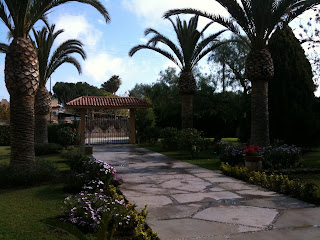Since we’ve been here for almost a month, we were thinking that it might be a good idea to share a little bit of how our every day life is. Many of our nearest and dearest know that before we moved here, were looking for a place in a village, not in a town or city, where we could try living the simple life in Sicily. That’s exactly what we were fortunate enough to get!
The house itself is a simple two story building on the side of a hill, overlooking olive and lemon trees in the garden and the rolling hills behind. The house is still under development by the owner, so only the first floor is in a livable condition, but we can see that it has great potential, especially because of its beautiful placement. It lies outside the village of Calamonaci and has only a few neighbours a bit further up the road.



One of the more amusing facts is that it doesn’t have an address, which always puzzled us, since we are dependent on the “commune” to supply us water to our water-tank, and therefore order it, but without an address! Luckily, the tabbachi owner in town knows the procedure, so every so often a little water truck pulls up outside and fills up our water tank in the garden. I don’t think we’ve ever been so aware of our water consumption as we are now that we can see how much two adults and a little baby actually use for every-day living.

Since it gets quite cold indoors at night, even in the mild Sicilian winter, the house has a wood burning stove and some electrical heaters, which we used frequently when we first arrived. This meant we had to learn how to make and maintain a fire in the stove; choosing the right placements for the wood, the kindling and the fire lighters. Tips about this from the grandparents were extremely useful. We also had to find the right person to order and buy wood from and do it all in Italian. Now that the weather is warmer, our new fire-making skills are no longer required, but we’ve been told that the weather here can change rapidly, so we don’t yet dare to put all the wood outside.

Most of the Sicilian homes we’ve seen (from actually being there or just peaking in from the street) have the kitchen as the entrance and heart of the house, but lack a living room. This is also the case for our house; meaning all our spare time in the evening is spent around the huge kitchen table, trying to watch Italian TV (that demands its own blog post) or reading.

The kitchen is basic but for food lovers like us, the huge gas stove is a real treat - until the gas runs out that is! When this happened another neighbour supplied us with a gas canister that we asked him to install, since that felt a little bit too dangerous to be handled by rookies from the big city.
So it seems that for most things to work here, you’re dependent on knowing the right people. We’ve seen this with our friends at the pasticerria, who pointed out the best fruit and veg stand, the best fish market, the best shops, hairdresser and seamstress. Though even on our own we’ve found that people’s kindness and generosity, plus their curiosity about us and especially our little one makes it easy to start conversations and find things out.

One of our neighbours owns sheep, and he had to hold back his sheep-dogs every time we walked by to stop them from attacking us. Little by little he inquired who we were and was happy to hear that a young couple from abroad found his little corner of the earth interesting enough to move to for three months. Now, not only he has become more and more friendly, but he also turned out to be the best supplier for wonderful fresh made ricotta cheese and pecorino, which he brings us about once a week for almost nothing.
People here generally don’t seem to be too strict with payments. By this we mean that if you don’t have the exact change for the baker, you are most welcome to come back another day and pay. And if you’re considered friends, like we are with the family at the pasticceria, it’s almost impossible for you to pay for anything. We’ve tried everything, from reasoning to sneaking euros under the pastry-tray, all with no success.

Another thing that we still haven’t really figured out is the shop and restaurant opening hours. The fact that they are all closed for the siesta between one and four is something we learned very early on, but then there are so many exceptions for when they are completely closed that we still keep turning up to the shops when the shutters are down, yet again. Until now we’ve figured out that everything except for restaurants and coffee shops are closed on Sundays, but in their turn they get to choose another day a week when they are “chiuso”. Wednesdays all food shops seem to be closed, at least in the afternoon, and for pharmacies and clothes shop there is a completely different schedule. Frustrating!
The Sicilians also have some unusual dress codes. For events that in Sweden or England would normally require casual or smart, Sicilians seem to opt for track suits or very comfortable clothing, even pyjamas. On other occasions, when we would keep it more low key, such as going out for pizza, they like to dress up and have a common understanding that it should be “black and tight” for women, and suits for men. We still get confused by this, so we’ve managed to feel both terribly under and overdressed. But hey, we’re still learning!





















































